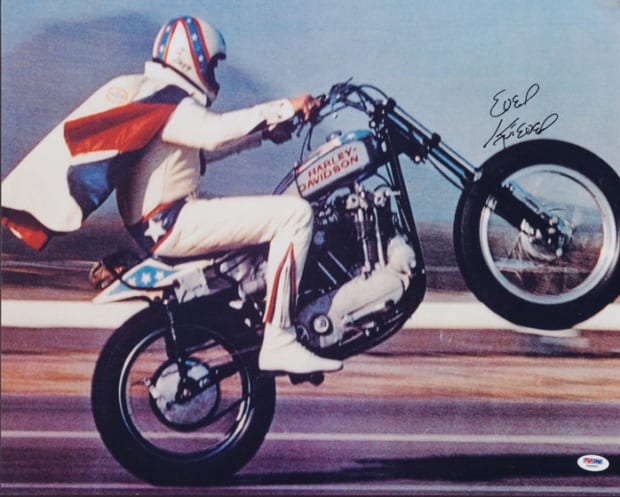#Antique #Diving #Helmets #Adventure #Awaits #Surface
Those who wore a diving helmet while making a living or serving our country were as brave as our imaginations allow them to be. And sometimes more so.
Motorcycle daredevil Evel Knievel wore a helmet. It was red, white and blue. Knievel jumped over big things, like buses and the fountains of Caesars Palace in Las Vegas. He crashed a lot. The helmet came in handy.
Photo courtesy of Heritage Auctions
Darth Vader, Iron Man and Thor all wore helmets. So does the circus performer who gets shot out of a cannon.
The Vikings, near the end of the 8th century, raided the British Isles. Their helmets were really scary, especially if you were English.
Chuck Yeager, the greatest test pilot in history, became the first person to break the sound barrier flying the Bell X-1 experimental jet some 40,000 feet over the Mojave Desert. In a helmet.
The helmet’s purpose in life is to protect. Helmets keep us safe. In theory. But the reason we love helmets is not because we are safety conscious. Just the opposite. We love helmets because chances are when you wear one you are on a collision course with danger.
In our heart of hearts, we know that the people who wear helmets are braver, more daring and far more rugged than we are. The Human Cannon Ball guy? Fearless. Maybe a little crazy, but still …
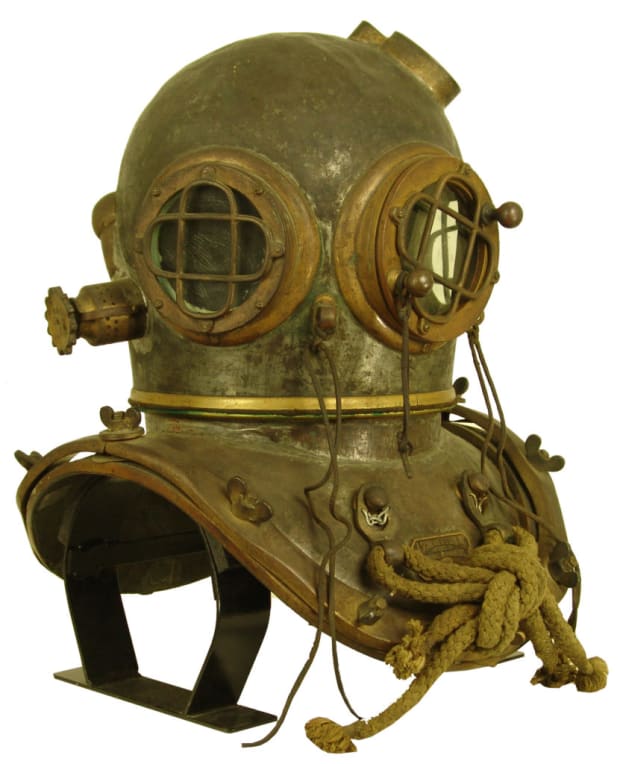
Photo courtesy Nation’s Attic
Of course, no helmet is cooler looking than a diving helmet. There can be no argument. You may disagree, but you would be wrong.
The men – and they were mostly all men – who wore a diving helmet while making a living or serving our country were as brave as our imaginations allow them to be. And sometimes more so. They risked their lives to save others. Or discovered treasures in some long-ago sunken ship. Or fought giant squids like the one in Jules Verne’s 20,000 Leagues Under the Sea.
They did all these things – and more – while bolted into these amazing steampunk helmets weighing about 65 pounds, crafted from spun copper with brass fittings and a faceplate and a valve that brought in compressed air hissing so loudly that a diver could barely hear himself think, let alone holler into a fixed speaker in the helmet that, if all worked just right, let them be heard by the guy topside feeding him air.
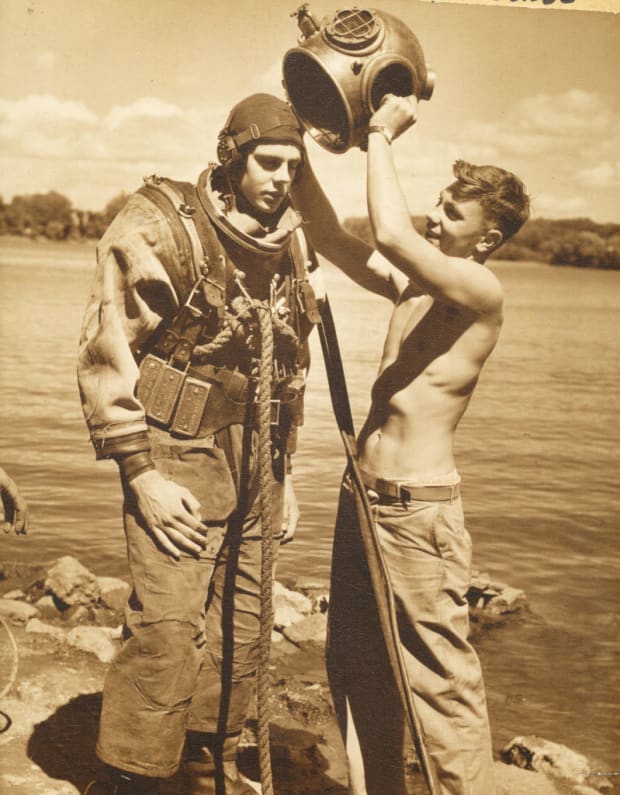
Photo courtesy Nation’s Attic
A diver in complete dress – helmet, suit, weight belt, weighted boots, etc. – lugged around 200 to 300 pounds while on the surface. You want to talk rugged? Let’s start there. Unless you move refrigerators on your back for a living, you have no idea just how tough that is. And yes, toughness is part of the allure.
No one understands this better than Don Creekmore, who with his wife, Jenny, runs Nation’s Attic, in Wichita, Kan., one of the leading businesses specializing in the buying and selling of antique diving helmets.
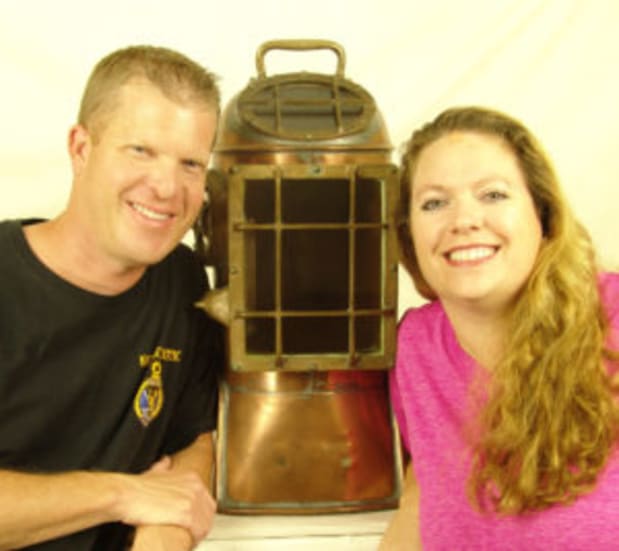
The very first diving helmet Don Creekmore saw was at an estate sale in Kansas. It was a Drager, a German-made helmet, pre-World War II. Creekmore was hooked.
“I don’t know if you would call it an epiphany,” Creekmore, 44, says, “but when I saw it, it was like, oh my gosh, what is this doing in Kansas? The history and mystery that surrounds a helmet really grabbed me. Undoubtedly it was in dangerous situations. Where had it been? What’s it seen? All I knew was it wasn’t here in Kansas forever, that’s for sure.”
Kansas offers a lot to brag about but an ocean view isn’t part of the Chamber of Commerce’s talking points. To make it to Kansas, a diving helmet has to really try.
“Unfortunately, provenance is rare,” Creekmore says of almost all diving helmets. “A lot of it comes down to your imagination. But as you talk to divers and you hear their stories of going into a ship and salvaging something. Or getting trapped, you start to think, wow, they were looking through this small glass and experiencing all of this.
“For many of our customers, a diving helmet is a bit of an impulse buy,” Creekmore says. “It’s not something in their consciousness that they are searching for until they see one.”
But when you do gaze upon one something clicks. Sometimes deep inside.
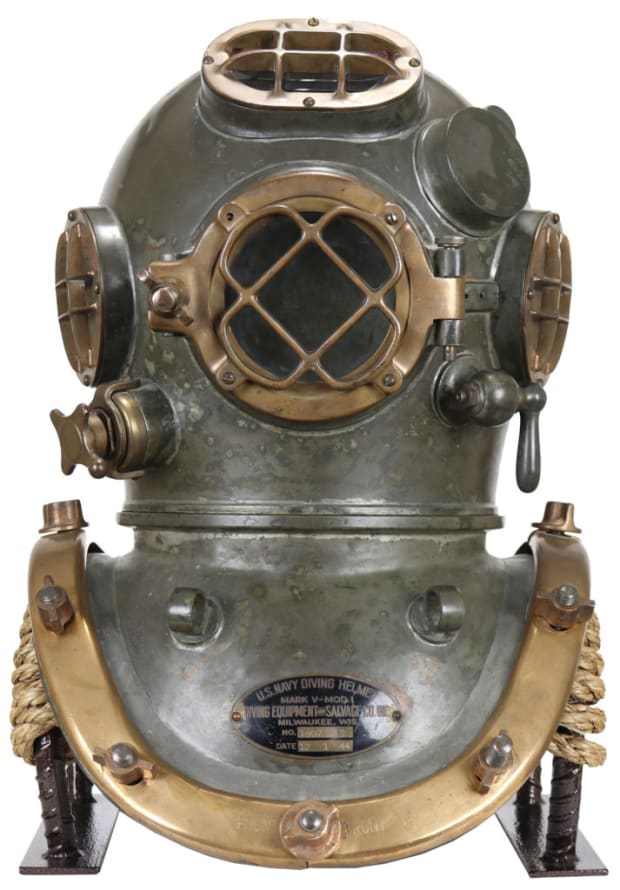
Photo courtesy Nation’s Attic
Diving helmets have been around in some form or another since the 1820s. Although manufactured worldwide, one of the best known diving helmets in the world is the US Navy Mark V. The Mark V was used by the Navy from 1916 to 1984, when the fiberglass helmet took over. In addition to the Navy, a lot of commercial divers used – and still use – the Mark V.
“The Mark V is by far the most common helmet by a factor of 10,” Creekmore says. “They made them in the tens of thousands. Yet that’s the helmet everybody knows and that’s the helmet everybody wants. They’re probably the coolest helmet ever made.”
But cool doesn’t come cheap. The average price of an American-made helmet runs between $3,000 and $10,000. An antique Mark V helmet sells for between $6,000 to $10,000. It’s possible to pay as much as $60,000 for a high-end helmet, but those are rare.
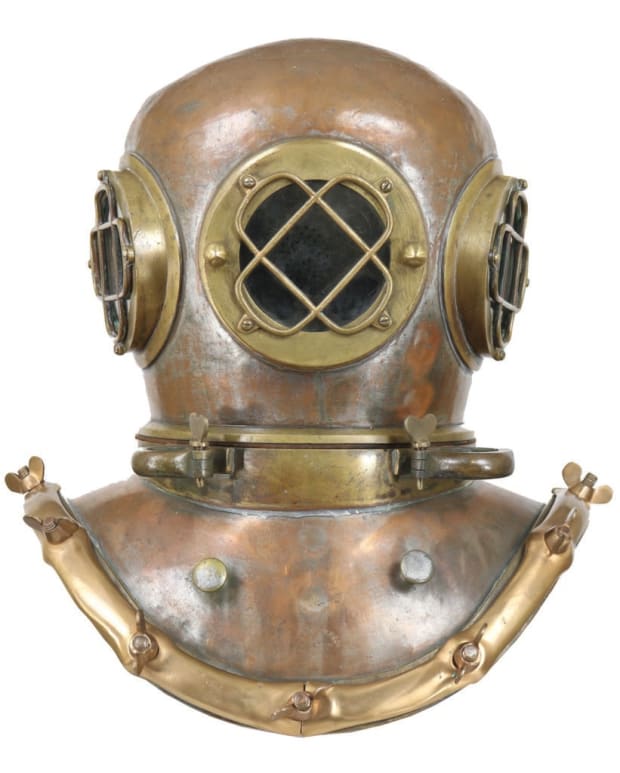
Photo courtesy Nation’s Attic
While rarity might be a factor in value, it is far from the determining factor.
“With helmets it’s the visual appeal,” Creekmore says. “The Mark V just happens to have the look.”
There were four main players manufacturing American-made helmets in the 20th century: A.J. Morse & Son, Boston; A. Schrader & Son, New York; Miller Dunn, Miami; and DESCO (Diving Equipment & Supply Company), Milwaukee. DESCO, which is still around today, was a major manufacturer of Mark V helmets during and after World War II. Their craftsmanship remains timeless and coveted.
Perhaps no event cemented the bravery and lore associated with the Mark V more than the one that unfolded on the morning of May 23, 1939, when a submarine, the USS Squalus, slipped beneath the storm-tossed surface of the Atlantic. Minutes into the maneuver, it suffered a major malfunction and began flooding uncontrollably. The Squalus sank to the ocean floor nine miles off the New Hampshire coast, trapping 59 men.
The men onboard were in a terrible fix. Since 1921, 825 men had died in submarine accidents. No rescue attempt had ever succeeded in more than 20 feet of water. The Squalus was down 240 feet.
A hastily assembled Navy team had no choice but to use new, experimental diving methods that fed divers a mixture of helium and oxygen to avoid decompression sickness, or the bends, associated with such depths. Until that moment, those diving methods existed only in theory.
The rescue team encountered problems that forced them to make decisions on the fly — each with life-or-death consequences. And they did it all with the world watching intently, captivated by the fate of the trapped men whose plight had been broadcast around the world.
Twenty-six crewmen died on the Squalus, but 33 were rescued during a 39-hour ordeal in one of the most daring and riveting rescues in naval history. In the end, the officers and men of the Squalus’ rescue and salvage team received four Medals of Honor, 46 Navy Crosses and one Distinguished Service Medal. While there were countless tears shed in the homes of those who didn’t survive the accident, a glorious new chapter was written in the history of underwater rescue.
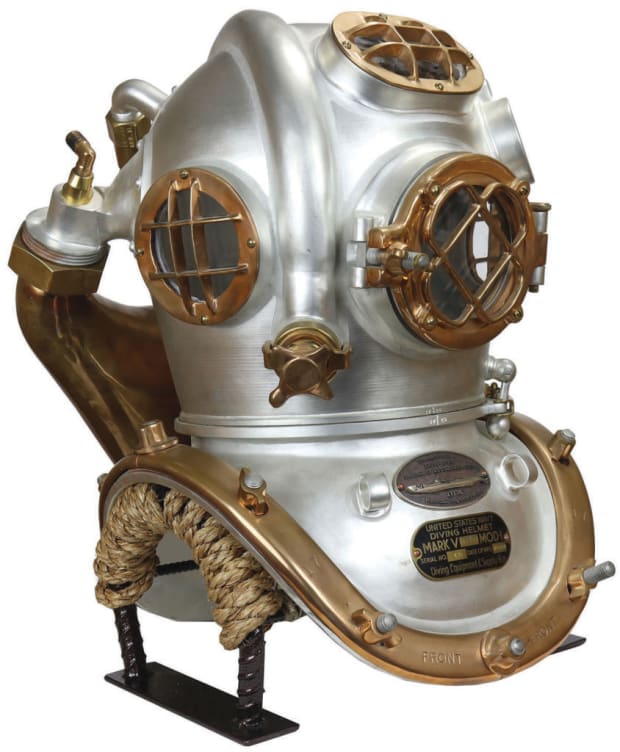
Photo courtesy Nation’s Attic
The Mark V mixed-gas helmet that came into use as a result of the rescue weighed more than 100 pounds and was far more complicated and dangerous to use. When viewed today they have a space-age quality about them. Visually and historically, they are nothing if not magnificent.
Helmets are easy to love. Maybe it’s the child in all of us, but there is something about the promise of peril, the hint of danger, a suggestion of the unknown that lies just beneath the surface that stirs the soul.
Yes, helmets are easy to love. But all helmets, like all adventures and all imaginations, are not created equal.
[youtube https://www.youtube.com/watch?v=3eATHzWNne4&w=560&h=315]
